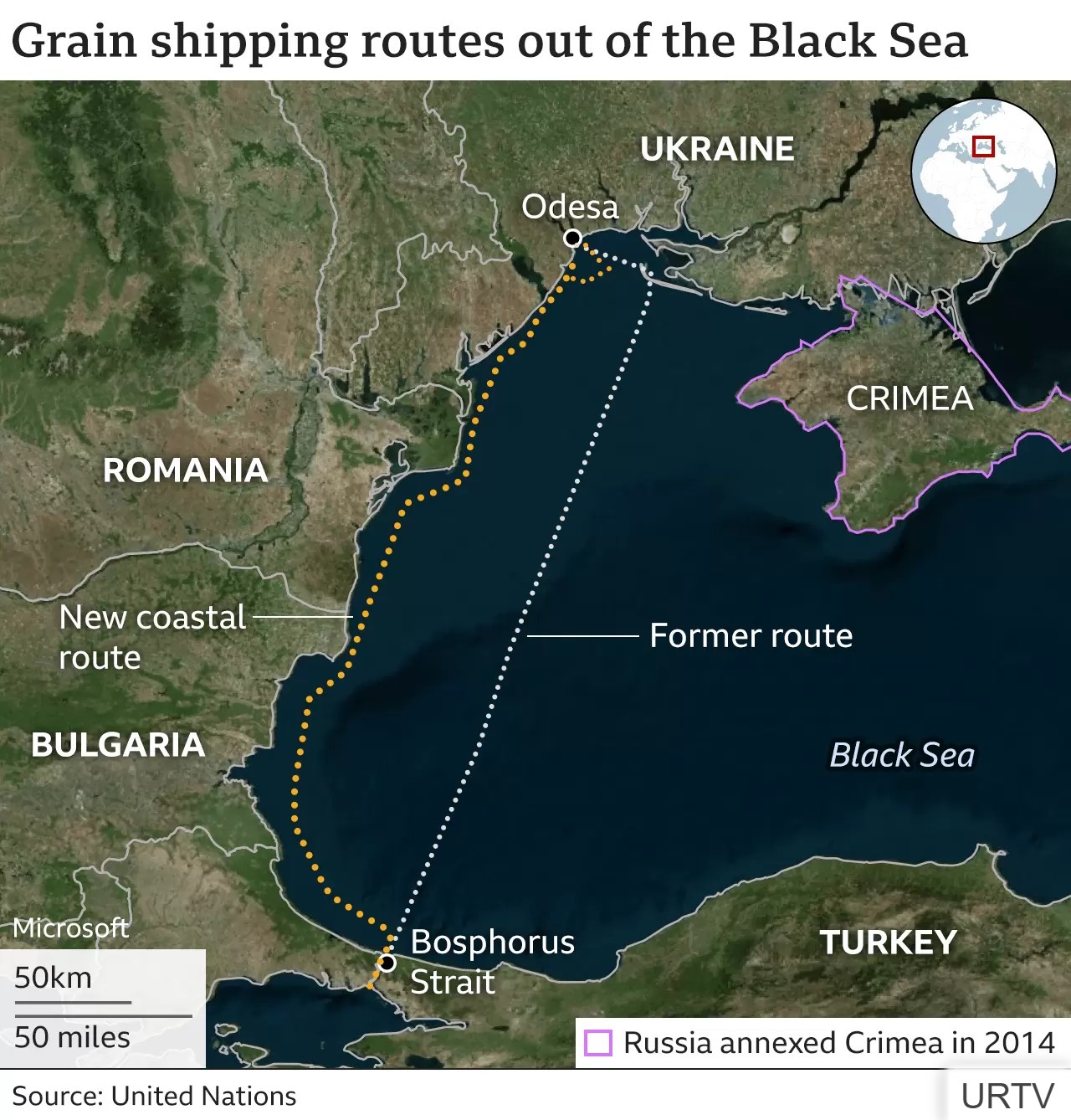Ukraine’s counter-offensive has now been under way for more than four months and may have now achieved a breakthrough ahead of the usually harsh winter.
Here are the latest developments:
- Ukraine says its forces have gained a foothold on the eastern bank of the Dnipro river – potentially allowing it to transfer vital equipment across the river
- Russia has been focusing its efforts on eastern Ukraine with fighting continuing around Bakhmut and near Donetsk

Ukraine’s claims foothold across river
Ukrainian forces say they have gained a foothold on the eastern bank of the Dnipro river about 30km (19 miles) from the city of Kherson.

The river has separated Ukrainian and Russian forces since Moscow’s troops withdrew from Kherson a year ago.
If the area is held it would mean a significant advance for Ukraine as it may be able to begin transferring armoured vehicles and air defence systems across the river putting it a step closer to breaking through to Crimea, the peninsula illegally annexed by Russia in 2014.
The success was claimed by Ukrainian President Volodymyr Zelensky’s chief of staff Andriy Yermak shortly after US-based experts said that marginal advances had been made into the village of Krynky, 2km (1.25 miles) inland from the river.
Russia conceded on 15 November that “small groups” of Ukrainian forces had set up positions in the village but insisted they had sustained heavy losses and had no chance of breaking through.
Vladimir Saldo, the Russian-installed official in charge of the Russian-occupied areas of the Kherson region, said they faced a “fiery hell”, adding: “Our additional forces have now been brought in. The enemy is trapped in Krynky.”
His admission that Ukrainian forces had gained a foothold came two days after Russian state media published and then swiftly retracted news of a retreat from positions on the eastern bank.
Ukrainian forces have conducted several raids in small boats across the Dnipro, Ukraine’s longest river, during the spring and summer. However, Kyiv lacks air superiority, which made the task more difficult.
The battle for Bakhmut
Russia’s main effort has been focused on eastern Ukraine, according to analysts from the US-based Institute for the Study of War (ISW).
The city of Bakhmut, which has endured some of the heaviest fighting of the war, has been under Russian control for several months and, although Ukraine gained some ground in the surrounding areas over the summer, including the villages of Kupyansk and Andriivka, the battles continue.

Russian forces are also claiming to have made advances around the town of Avdiivka near the city of Donetsk.
President Zelensky said on 14 November that fighting was escalating near the town but added that Russian forces were losing men and equipment trying to capture it.
The UK Ministry of Defence says Russia is “almost certainly attempting a pincer movement to encircle the town”, and notes its proximity to Donetsk means it holds political importance to Russia.

The MoD assessment is that recent advances suggest Russian forces are closing in on the coke and chemical plant to the north of the town, which is still held by Ukrainian forces and occupies a key tactical position.
The plant dominates the main road into Avdiivka and, the MoD believes if Russian forces were to secure it, resupplying the town would “become increasingly difficult for Ukraine”. However the building gives Ukraine a “localised defensive advantage” and the MoD says that Russian forces will probably suffer significant losses if they attempt to assault the facility.
Attacks on Crimea
As part of its counter-offensive Ukraine has also stepped up attacks on the Crimean peninsula – including a missile attack on the port of Sevastopol on 22 September which it says killed 34 Russian officers.
That attack came just over a week after another major attack on the same city, which is the headquarters of the fleet, that is thought to have destroyed a ship and a submarine.
It also caused significant damage to the dry docks, which are vital for maintenance of the entire Russian Black Sea fleet.
The next day Ukraine said it had succeeded in destroying a sophisticated Russian air defence system – the S-400 – on the peninsular.
Attacks in late August destroyed another S-400 and others knocked out Russian radar positions on offshore gas platforms.

Russia’s Black Sea fleet is an important target for Kyiv – its ships have launched missiles at Ukraine causing devastating damage.
It has also been threatening to block the Black Sea shipping routes that Ukraine has been using to export grain – which is a particular sticking point for Kyiv currently.
Moscow pulled out of the internationally brokered Black Sea Grain Initiative in mid-July, which guaranteed safe passage of non-military vessels, arguing that Russia’s own agricultural exporters were being disadvantaged.
In its place Ukraine exported a limited amount of grain using ships that hugged the western coast of the Black Sea – through Romanian and Bulgarian territorial waters – to evade Russian attack. Ukraine has also been exporting an increasing amount of grain from Reni and Izmail, on the Danube river.

The Black Sea route was previously used as a humanitarian corridor, to allow passage for empty ships which had been trapped in Ukraine’s ports since the start of the conflict.
However, earlier in November Ukrainian officials said a harbour pilot had been killed and four other people injured after a Russian missile hit a civilian ship that was supposed to transport iron ore to China as it was entering Odesa.
More than a year of fighting
Russia’s invasion began with dozens of missile strikes on cities all over Ukraine before dawn on 24 February 2022.
Russian ground troops moved in quickly and within a few weeks were in control of large areas of Ukraine and had advanced to the suburbs of Kyiv.
Russian forces were bombarding Kharkiv, and they had taken territory in the east and south as far as Kherson, and surrounded the port city of Mariupol.

ut they hit very strong Ukrainian resistance almost everywhere and faced serious logistical problems with poorly motivated Russian troops suffering shortages of food, water and ammunition.
Ukrainian forces were also quick to deploy Western supplied arms such as the Nlaw anti-tank system, which proved highly effective against the Russian advance.
By October, the picture had changed dramatically and having failed to take Kyiv, Russia withdrew completely from the north.
More than a year since the invasion, Ukraine is now hoping its latest counter-offensive can turn the war in its favour.
By Andrew Isaac, David Brown, Bella Hurrell, Dominic Bailey, Mike Hills, Lucy Rodgers, Paul Sargeant, Alison Trowsdale, Tural Ahmedzade, Chris Clayton, Kady Wardell, Mark Bryson, Zoe Bartholomew, Sean Willmott, Sana Dionysiou, Joy Roxas, Gerry Fletcher, Jana Tauschinsk, Debie Loizou, Simon Martin and Prina Shah.

About these maps
To indicate which parts of Ukraine are under control by Russian troops we are using daily assessments published by the Institute for the Study of War with the American Enterprise Institute’s Critical Threats Project. To show key areas where advances are taking place we are also using updates from the UK Ministry of Defence and BBC research.
The situation in Ukraine is often fast moving and it is likely there will be times when there have been changes not reflected in the maps.

NewLatter Application For Free
































